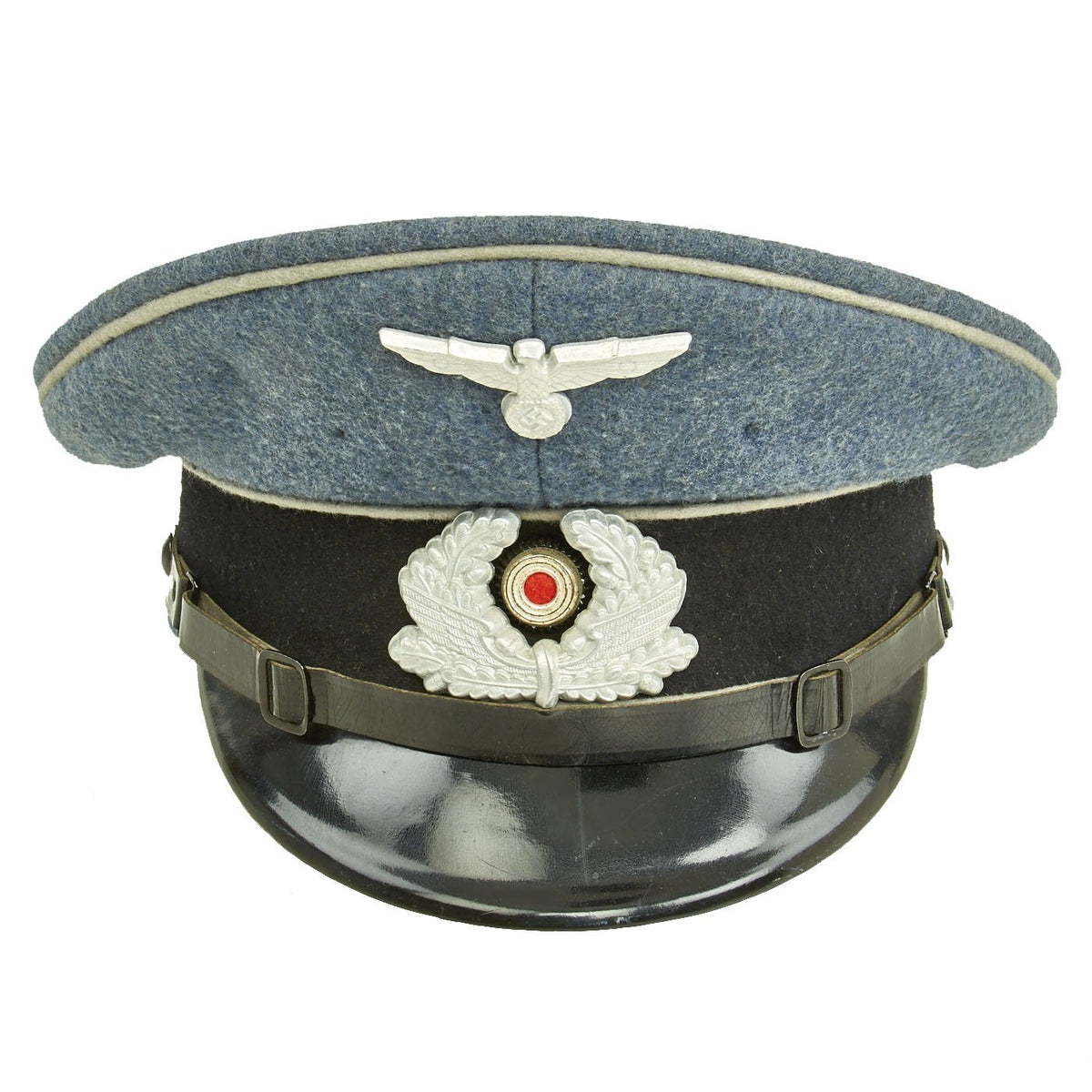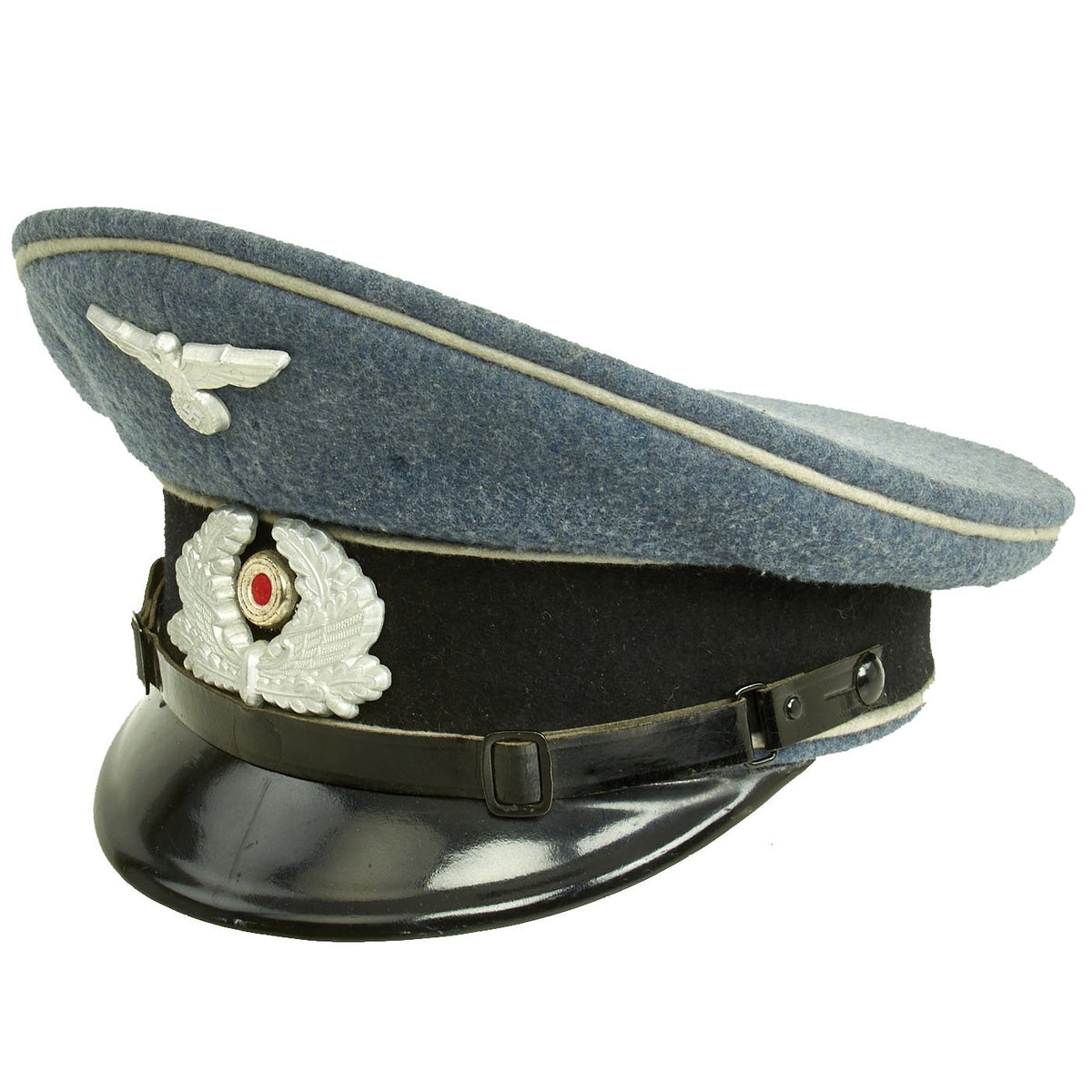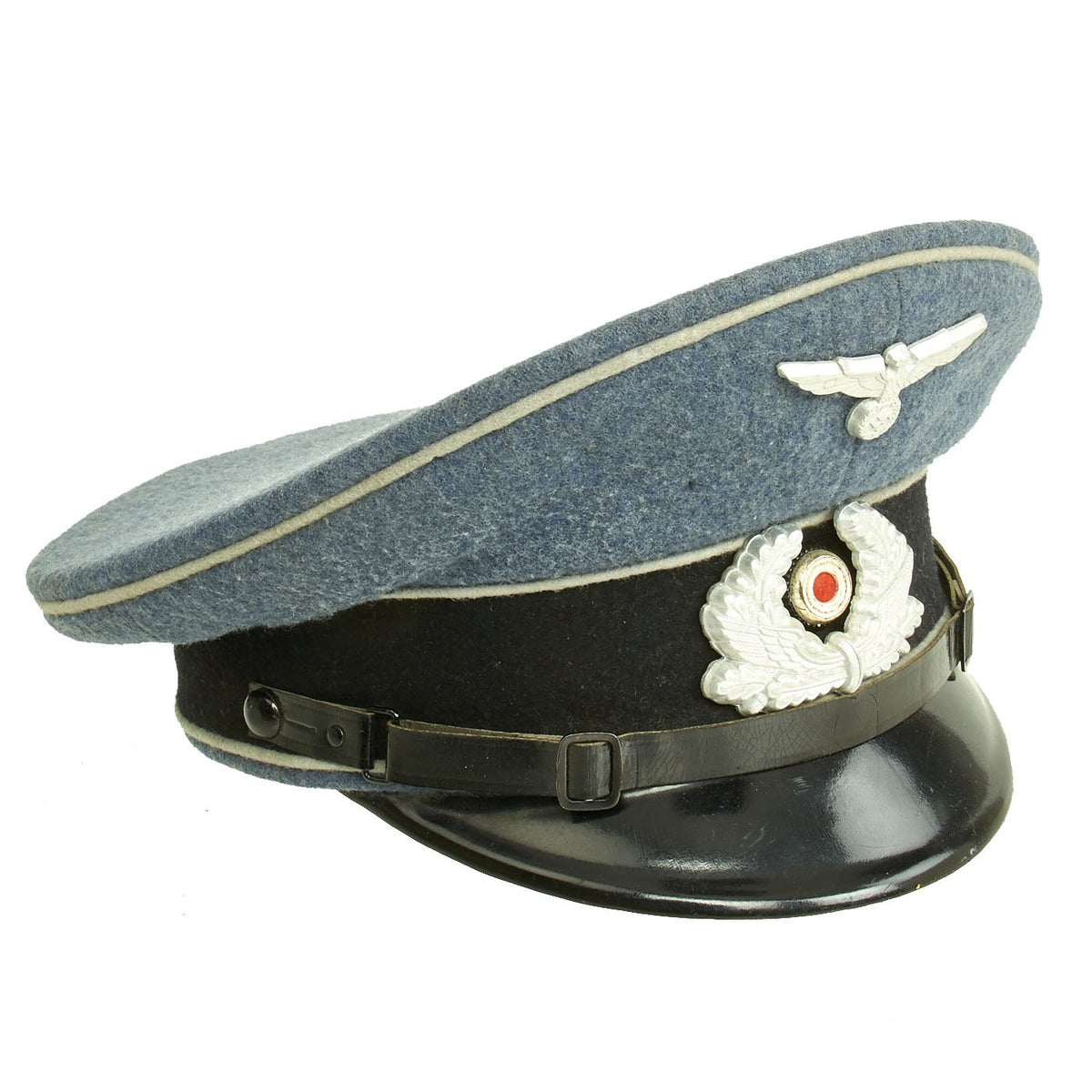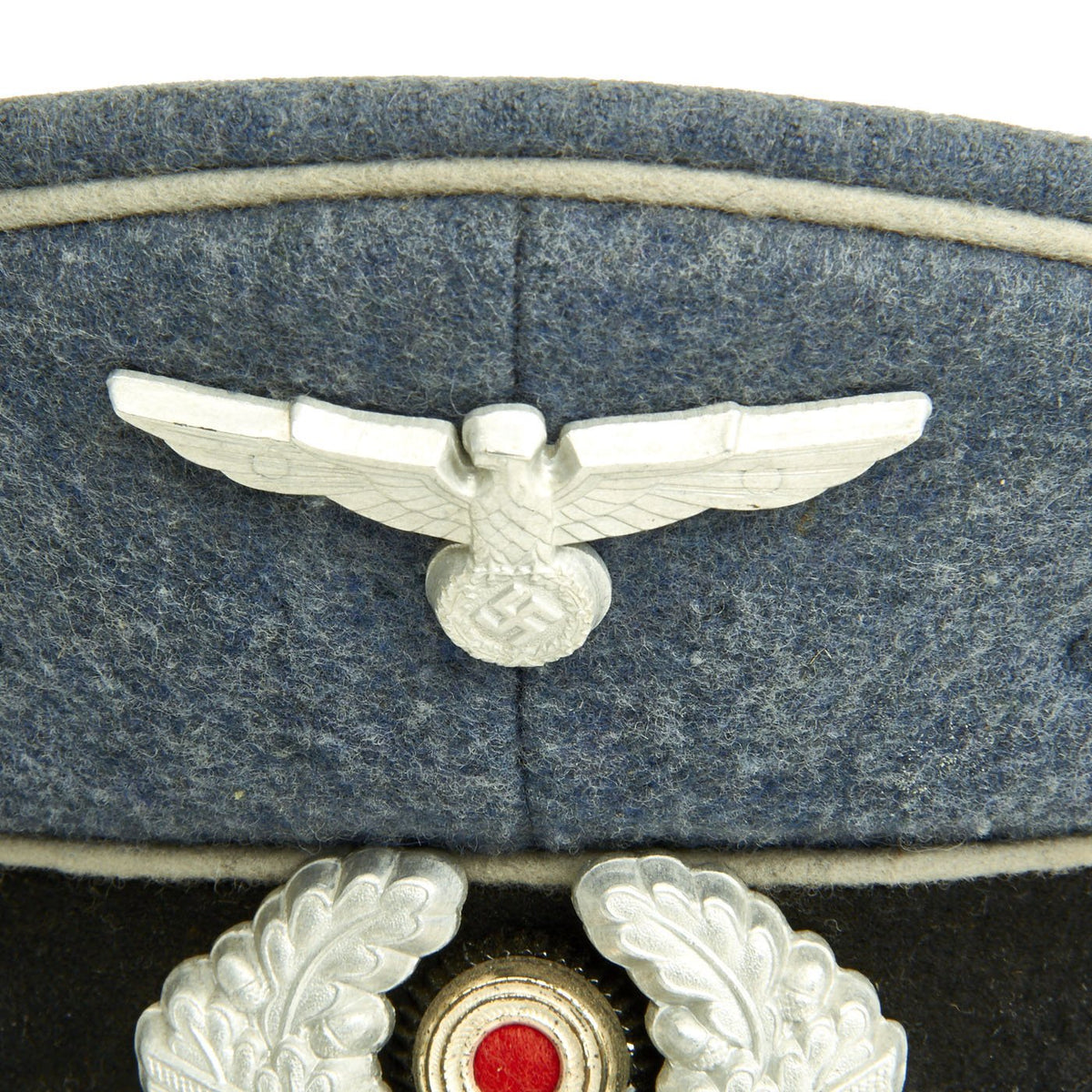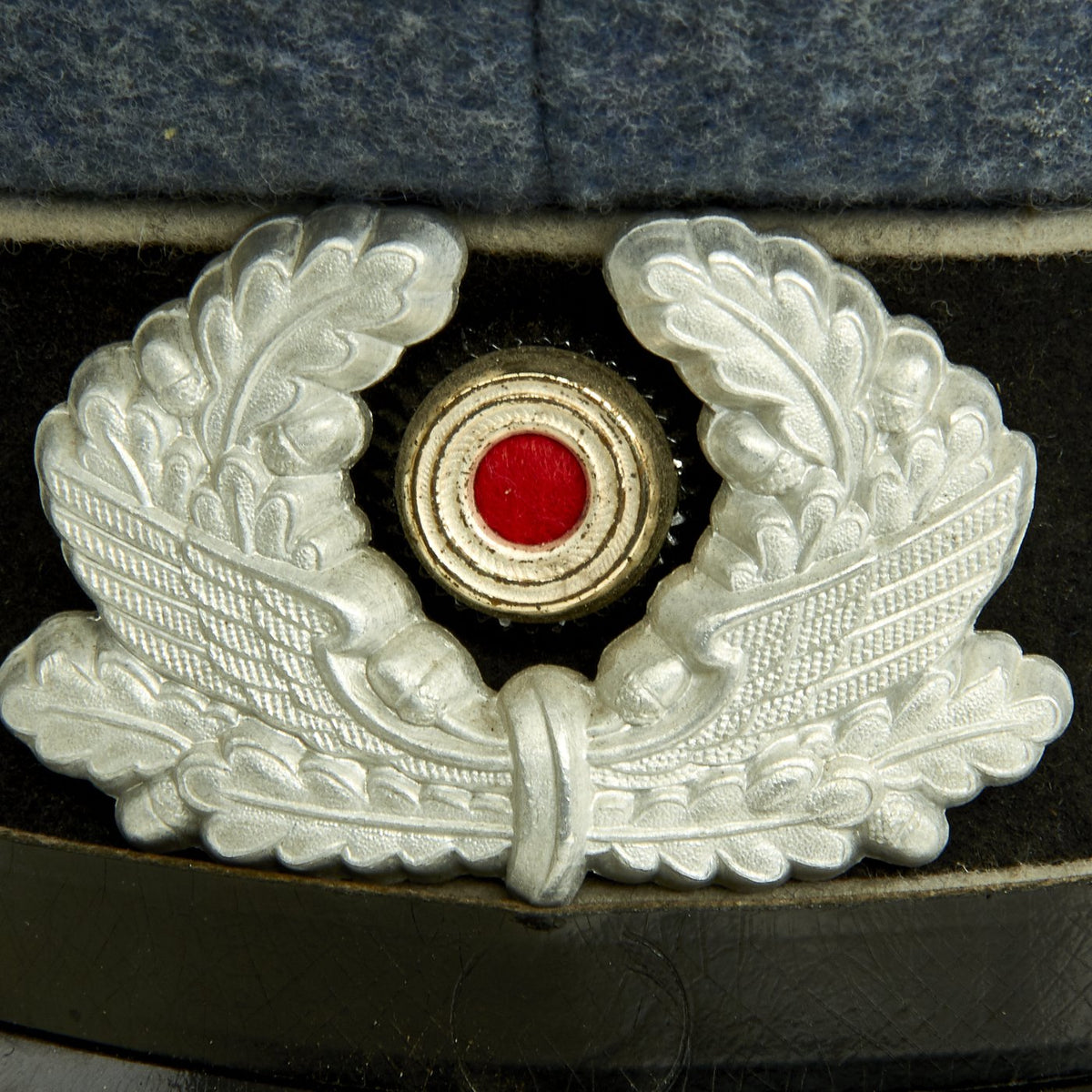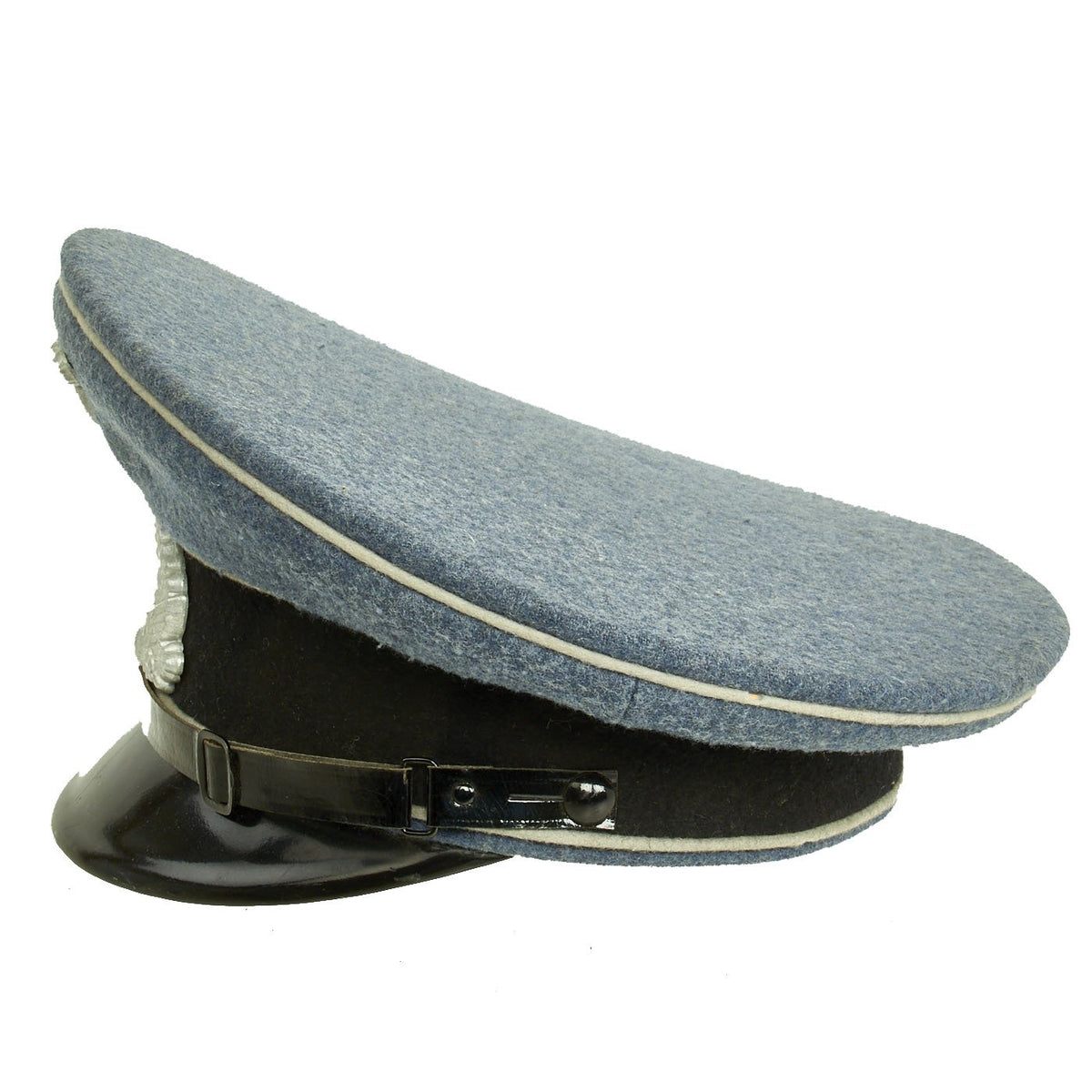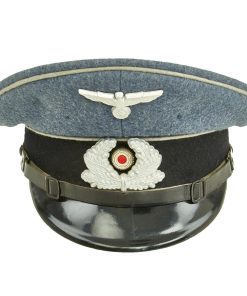Original German WWII DRB Bahnschutzpolizei Railway Police Visor Cap by Clemens Wagner – 58cm Original Items
$ 795,00 $ 238,50
Original Item: Only One Available. This is an excellent condition example of a German WWII DRB Bahnschutzpolizei (Railway protection police) Schirmmütze (visor cap). This example shows high quality fabrication, made with the correct light blue-gray worsed wool with a black wool cap band and a traditional high front. The cap has light gray Waffenfarbe (corps color) piping along the top edge and flanking either side of the band, indicating the branch to be Railway.
It is decorated with a well detailed silvered aluminum eagle insignia on the peak and and an open silvered aluminum oak leaf and acorn wreath surrounding a metal tri-color cockade with a red felt insert on the band. The wreath also incorporates the “Winged Wheel” DRB emblem on the bottom, which is specific to the Railway Protection Police. The dual-buckled black leather chinstrap, designating the wearer to be an enlisted man, is attached to black lacquered buttons on either side. The vulcanfibre visor has a smooth black leather-look upper, exhibiting slight wear along the edge and is tan on the underside. The tan leather sweatband is in good supple condition, with only light wear and no tearing
The inside of the cap is lined with blue rayon sheer fabric. The top plastic shield is fully present. It still bears the makers logo and name CLEMENS WAGNER underneath, in blue print, which is still fully visible. The size is indicated as 58, and the name tag slot is empty.
The condition of the cap is quite nice, though as with many wool caps, there are some moth nips to the exterior, though mostly in the nap of the fabric. The interior shows little to no wear, though there is some degradation and damage to the padding under the front of the sweatband.
An excellent example of a rare German WWII Railway Protection Police visor cap, ready to add to your collection!
The Deutsche Reichsbahn, also known as the German National Railway, the German State Railway, German Reich Railway, and the German Imperial Railway, was the German national railway system created after the end of World War I from the regional railways of the individual states of the German Empire. The Deutsche Reichsbahn has been described as “the largest enterprise in the capitalist world in the years between 1920 and 1932”, nevertheless its importance “arises primarily from the fact that the Reichsbahn was at the center of events in a period of great turmoil in German history”.
Deutsche Reichsbahn (1937 to 1945)
With the Act for the New Regulation of the Conditions of the Reichsbank and the Deutsche Reichsbahn (Gesetz zur Neuregelung der Verhältnisse der Reichsbank und der Deutschen Reichsbahn) of 10 February 1937 the Deutsche Reichsbahn Gesellschaft was placed under Reich sovereignty and was given the name Deutsche Reichsbahn (DRB).
World War II and military use
The Reichsbahn had an important logistic role in supporting the rapid movement of the troops of the Wehrmacht for most of the important Pre-WWII and early war campaigns.
In all the occupied lands the Reichsbahn endeavored to incorporate the captured railways (rolling stock and infrastructure) into their system. Even towards the end of the war the Reichsbahn continued to move military formations. For example, in the last great offensive, the Battle of the Bulge (from 16 December 1944), tank formations were transported from Hungary to the Ardennes.
The DRB was instrumental to the entire functioning of the Third Reich, as the primary method for transportation of materiel and people. This unfortunately extended to uses for prisoners and Shoah victims as well.
The German Schirmmütze Visor Cap:
The visor cap (Schirmmütze) was an important part of the headgear worn by German uniformed military, civil, paramilitary and political organizations during the Third Reich. This was the standard cloth headgear worn as a part of the service uniform. Visor caps were worn outdoors as well as indoors, and were often required to be worn by all personnel on duty. Visor caps were made in versions specific to each organization and were often further differentiated through the use of insignia, colored piping, or style of chin cord, to indicate rank, role or branch. The insignia used on these caps ranged from simple stamped metal emblems, to elaborate hand embroidery. Visor caps were issued to enlisted soldiers and NCOs in the military and in some other organizations. Officers had to purchase their own hats, and lower ranks could choose to purchase caps that were of a higher quality than the rather basic, issue examples. The private purchase caps were generally made in very high quality, with fine materials. A wide variety of fabrics were used, from Trikot and doeskin, to heavy wool, or even lightweight white fabric for summer wear. In the military, issue of these caps was generally suspended shortly after the outbreak of the war, but they continued to be worn by some troops until the end of the war.
Fast Shipping with Professional Packaging
Thanks to our longstanding association with UPS FedEx DHL, and other major international carriers, we are able to provide a range of shipping options. Our warehouse staff is expertly trained and will wrap your products according to our exact and precise specifications. Prior to shipping, your goods will be thoroughly examined and securely secured. We ship to thousands clients each day across multiple countries. This shows how we're dedicated to be the largest retailer on the internet. Warehouses and distribution centres can be located throughout Europe as well as the USA.
Note: Orders with more than one item will be assigned a processing date depending on the item.
Before shipping before shipping, we'll conduct a thorough inspection of the items you have ordered. Today, the majority of orders will be delivered within 48 hours. The delivery time will be between 3-7 days.
Returns
The stock is dynamic and we cannot completely manage it because multiple stakeholders are involved, including our factory and warehouse. So the actual stock may alter at any time. It's possible that you may not receive your order once the order has been made.
Our policy is valid for a period of 30 days. If you don't receive the product within 30 days, we are not able to issue a refund or an exchange.
You can only return an item if it is unused and in the same state as the day you received it. You must have the item in its original packaging.
Related products
Uncategorized
Uncategorized
Uncategorized
Armored Burgonet Helmet & Polearm from Scottish Castle Leith Hall Circa 1700 Original Items
Uncategorized
Uncategorized
Uncategorized
Band of Brothers ORIGINAL GERMAN WWII Le. F.H. 18 10.5cm ARTILLERY PIECE Original Items
Uncategorized
Uncategorized
Uncategorized
Uncategorized
Uncategorized
Uncategorized
Armoured Fighting Vehicles of the World: AFVs of World War One (Hardcover Book) New Made Items
Uncategorized
Uncategorized
Uncategorized
